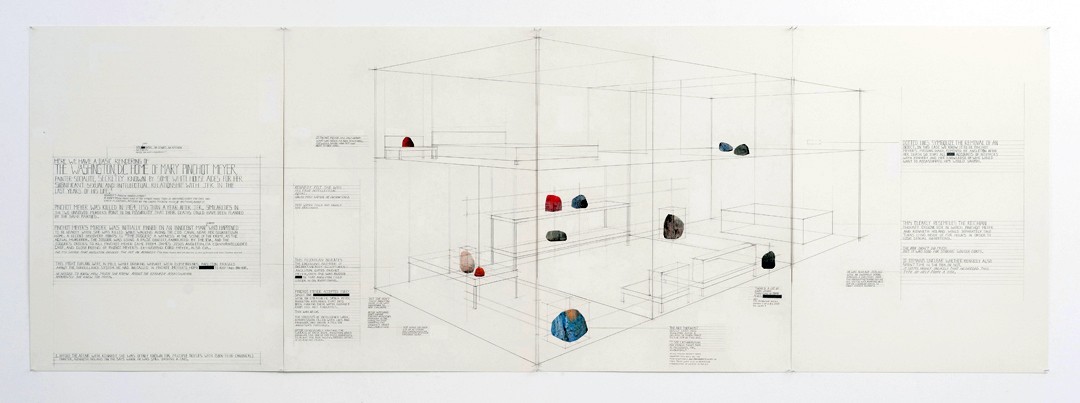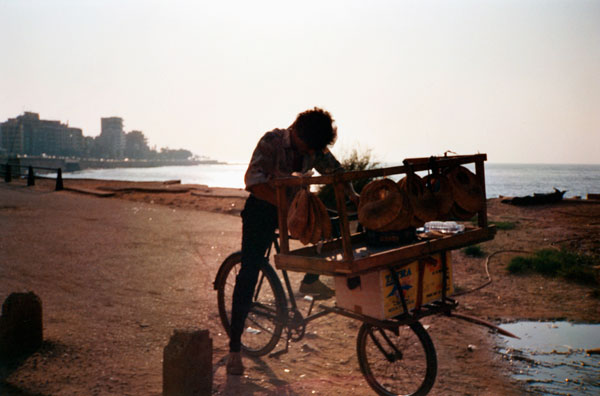
ABOVE: !Mediengruppe Bitnik, Ashley Madison Angels at Work in Louisville
Photos courtesy of Ruckus
Photos courtesy of Ruckus
︎ Cressman Center for Visual Arts, Louisville
Conspiratorial Aesthetics
Review
Conspiratorial Aesthetics is flooded with overlapping text, voices, and video, modulating a gallery’s assumed credibility into vulnerability. Curated by Chris Reitz, the artists included in this exhibition pose concerns on truth, history, and how these both play a role in the legibility of art. The curatorial statement, in turn, asks, “Can art offer counternetworks of information? Can art offer any information? Or does it instead only produce the world it claims to know?” These questions echo throughout the works as ontological considerations in how to navigate an era inundated with information with inherently susceptible minds.
Immediately upon walking through the gallery door, one is addressed by five female voices, lingering, as if an exchange should be reciprocated. The intermittent and loud audio component of !Mediengruppe Bitnik’s Ashley Madison Angels at Work in Louisville (2018) is unavoidable and a partially indecipherable blanket of noise over the experience in the rest of the space. The source of these voices are revealed halfway through a natural circumnavigation of the gallery: five monitors shrouded in a sultry pink light display five beautiful yet lo-fi graphic faces, each wearing a glittery mask. From the wall text, one discovers the alluring voices were collected from a preexisting internet platform designed for intimate propositions and the voices in the gallery were the bots produced to target love seeking individuals in Louisville. These voices elicit a multitude of terrifying and humorous effects while imagining oneself on the receiving end of artificial intelligence's seduction.
Deb Sokolow’s, A Case Study in Schematics, Surveillance and Murder (2015) offers an encyclopedic account of a John F. Kennedy affair and a detailed architectural rendering of all the bugged rocks planted in the mistress’s house that surfaced as evidence. A serious, yet witty tone is found in the detail and formal qualities of Sokolow’s precise hand-drawn text in graphite and diagrams with collage on paper. The one-off quality of each of Sokolow’s prints seems to contrasts with their conviction because of how easily the work could be erased or destroyed, hinting at the fatalistic vulnerability of such information. The resemblance to a believable narrative strongly suggests the notion as reality but unequivocally is an alternate reality.
Repetition within the exhibition and cues toward truth—the text, labels, and names that are connected to the work—all build an understanding that the works are visual truths; they are autonomous and true in their existence, yet collude with modes of cultural and political misinformation. Conspiracy or the sharing of secrets, although deceptive in nature, still appeals to curiosity and prompts the consideration of anything within these works as being neither completely true or untrue.
Cara Benedetto’s graphic silhouette shooting targets are laden with intimate confessions and brute injury. The emasculated target practice prints are subjugated not with bullet holes, but diary or sketchbook entries––the information colored by the romanticism of handwritten notes and overt gestures of imaginary bodies. They read initially as store-bought targets, spontaneously graffitied with incriminating “personal” truths of lost love and awkward confessions. They are, in reality, lithographs produced by the artist in a purposeful repetition that mimics the tireless annotations. This rhythm and physicality are most clearly demonstrated through Stone Broke (2018), a bare target silhouette printed on stone lying face up and completely fractured. The vulnerability of this work, lying close to the floor in an open wooden box resembling a cross between an antique museum crate and casket, murmured a more severe brutality.
Immediately behind Cara Benedetto’s broken plinth is a monitor displaying Walid Raad/Atlas group’s I only wish I could weep (2002). The footage is sourced from a military operative in the Lebanese war who was instructed to surveil a specific area but instead redirected the camera to record daily sunsets. Redirecting an act of war toward a ritual and sublime occurrence is simultaneously romantic and unnerving. Again, Conspiratorial Aesthetics provides enough to provoke an emotional reaction but not enough to distinguish reality from fiction: betraying a willingness to follow and experience tender sentiments absent any grounding context.
The art gallery is a stage for information that is folded into visual credibility. Conspiratorial Aesthetics plays into the confidence of the distinction between fiction and reality while also disrupting art’s relationship to the real. The artwork in this exhibition dives deeply into concerns from our current cultural reality: where information and presentation are easily conflated to create narratives which seem genuine, but always carry a lingering doubt.
-
Conspiratorial Aesthetics is on display at the Cressman Center for Visual Arts until Saturday, April 13th 2019.
Cressman Center for Visual Arts is located at 100 E Main Street Louisville, KY 40202, and open Wednesday - Friday: 11:00am - 6:00pm, Saturday: 11:00am - 3:00pm.
Beth Heustis
Guest Contributor for Ruckus
4.3.19
Install, courtesy of Ruckus

Cara Benedetto, Stone Broke (2018)

Deb Sokolow, A Case Study in Schematics, Surveillance and Murder (2015)
 Walid Raad/Atlas group, Still from I only wish I could weep (2002)
Walid Raad/Atlas group, Still from I only wish I could weep (2002)






